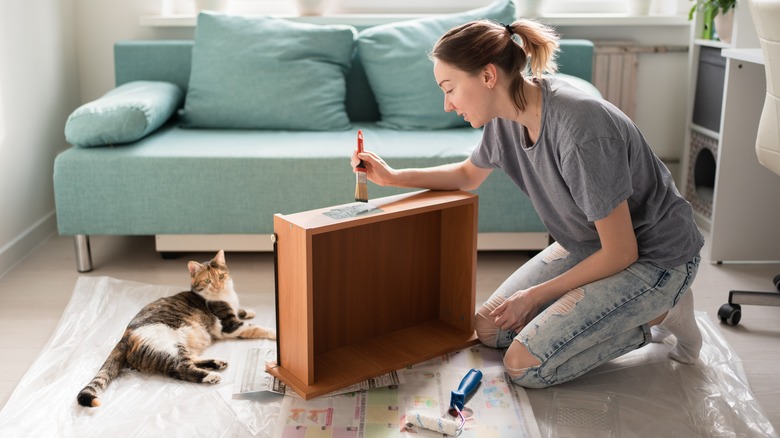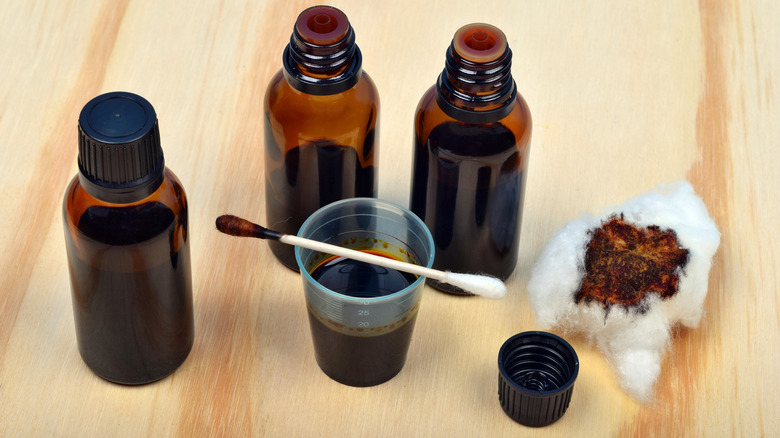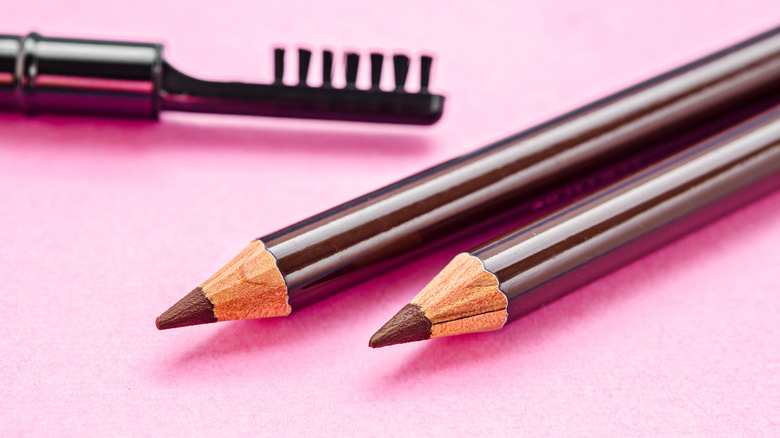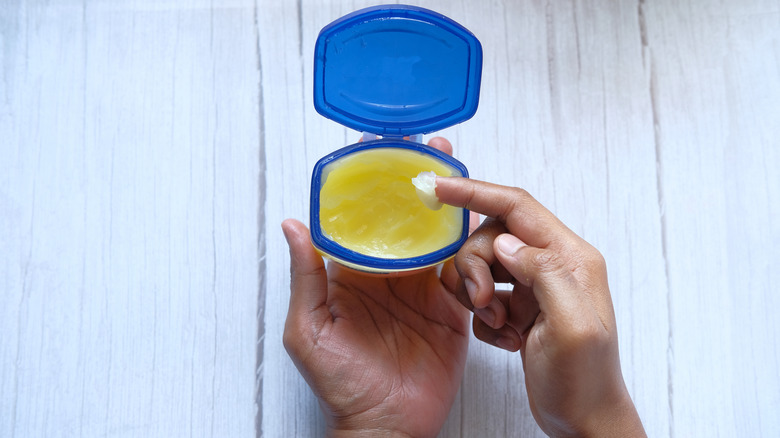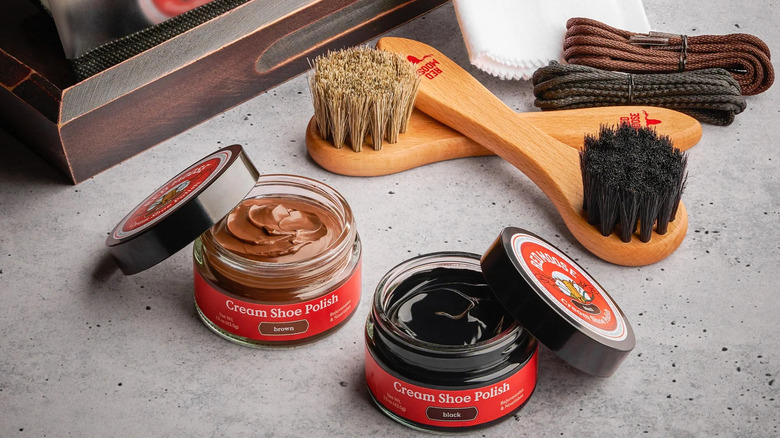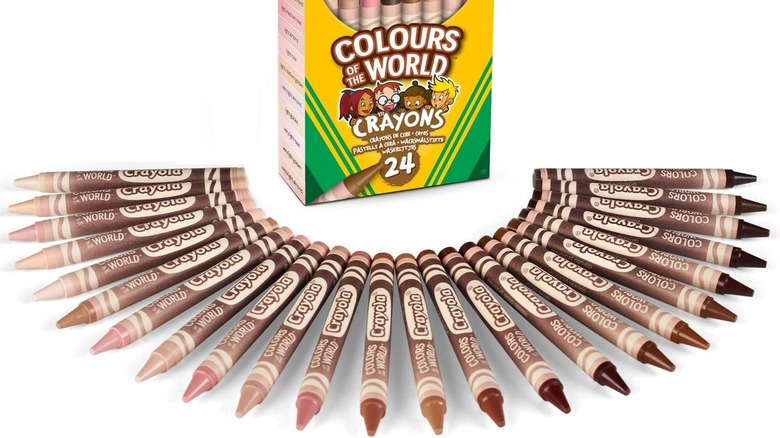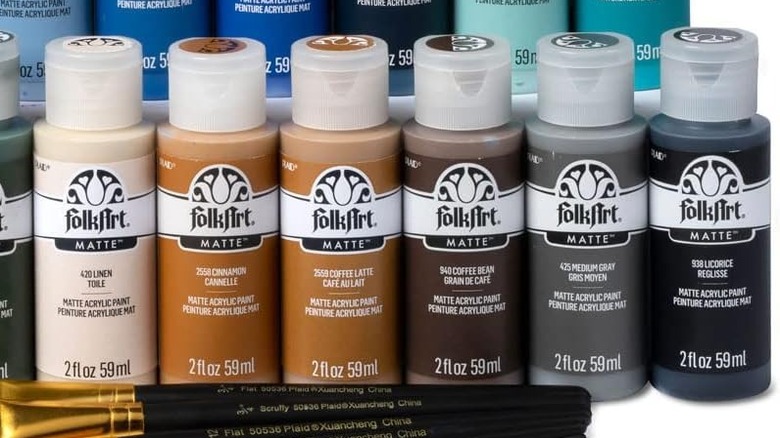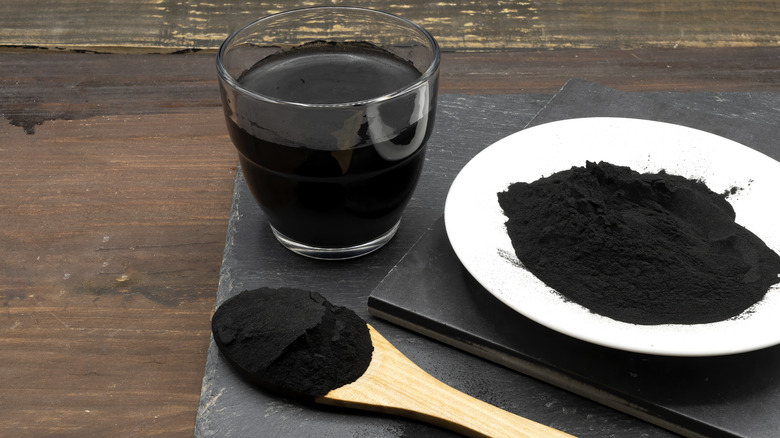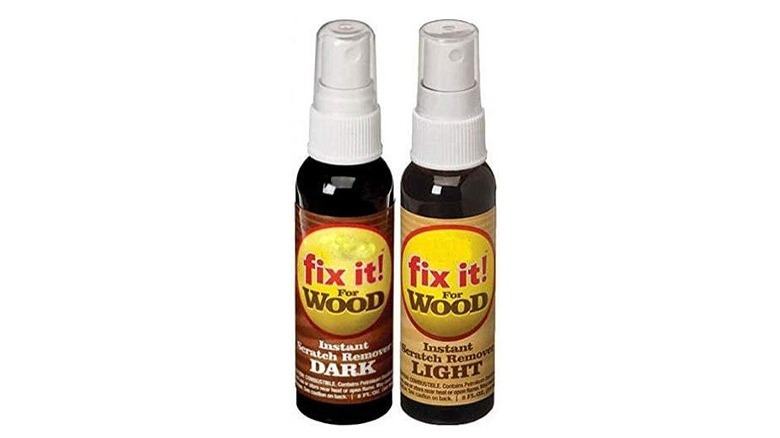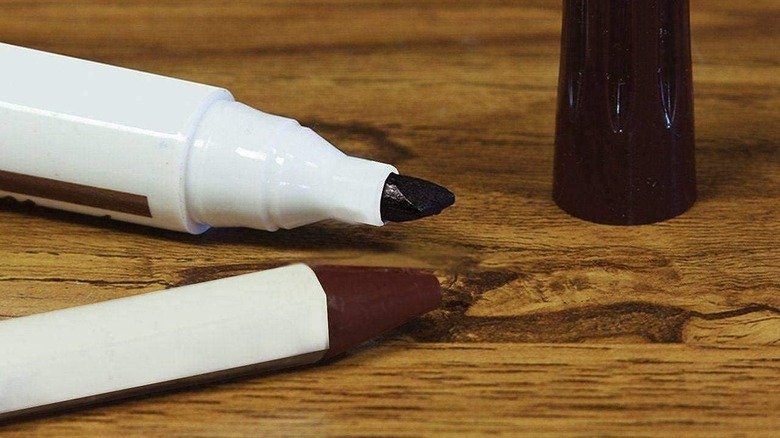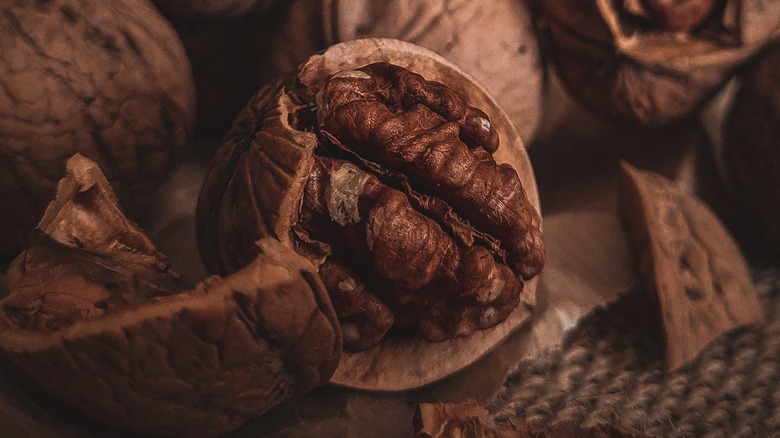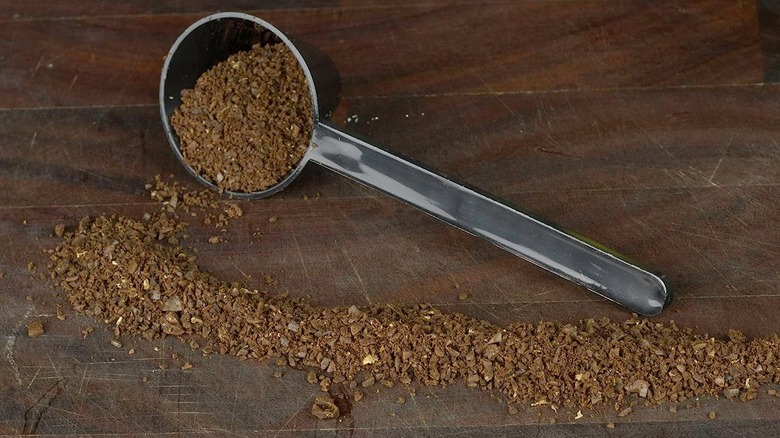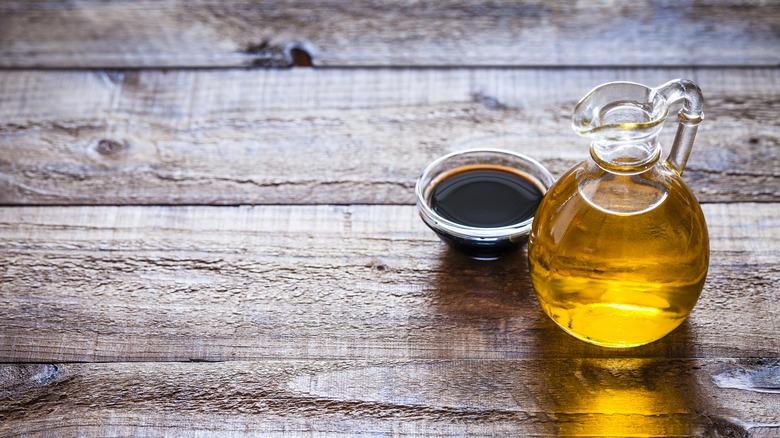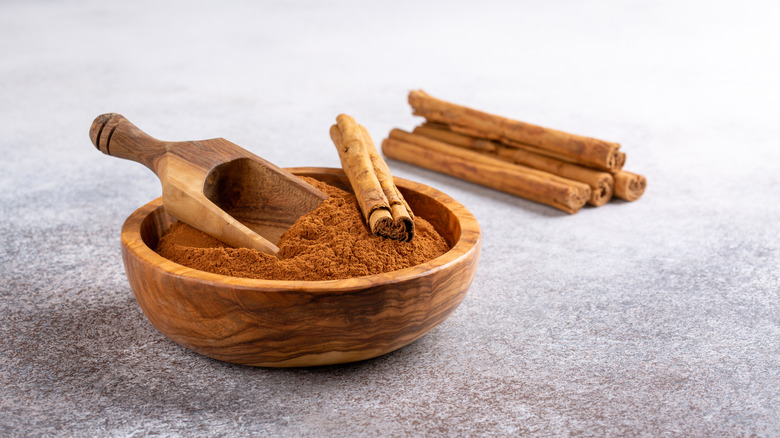13 Hacks To Easily Erase Stubborn Wood Furniture Scratches
We may receive a commission on purchases made from links.
Whether carved from all-natural trees or engineered from scrap and fibers, wooden furniture is functional, durable, and makes a stylish addition to interiors. Like all furnishings, wood is susceptible to damage over time. You can lessen the risk by purchasing hardy and reliable furniture brands and keeping it sealed with a top-quality finish, but there is still potential for scratches to appear in the wood grain.
Sliding drink coasters, rearranging tabletop decor, and bumping against your furniture can cause light abrasions on the surface. Depending on the wood's darkness and the grain's intricacy, these blemishes can be a blight on your interior design. Fortunately, over the centuries of using wood furniture, people have invented copious temporary and permanent solutions for hiding surface scratches. These solutions utilize unexpected household accessories, including bathroom supplies, arts and crafts, specialized products, and even food products. Let's see which one will work best for your particular needs.
Iodine solution
Cheers to the first person to discover that first-aid products are good for more than just fixing up human bodies. Iodine solution, a topical antiseptic, is a tincture sold at convenience stores, grocery stores, pharmacies, and anywhere else with basic medical supplies. The chemical concentrations turn these antiseptics into yellow, orange, and brown colors with red and purple tints. The rich colorings make these products ideal for masking scratches on mahogany and cherry wood furniture.
Before you begin dying your furniture with antiseptic, you should pour the solution into a glass. Dilute it with water until it is the same color tone as your furniture. Once you get the iodine to your desired color, dip a cotton Q-tip or thin paintbrush in the solution and swipe it along the wood scratches. Allow the solution to dry before applying more layers, repeating the process until the scratch camouflages with the rest of the table. Iodine is a dye, so expect the application to be permanent. You won't need to worry about touching up the former scratch unless you accidentally damage your table and scrape the same surface. If you accidentally apply too much iodine (by not using the recommended applicators above), you must act quickly by cleaning it up with mild soap and hot water.
Cosmetic makeup
We already use cosmetic makeup to cover up perceived facial flaws, so why not also use them to correct the aesthetics of wooden furniture? Eyebrow pencils often come in brown, red, and black colors similar to wood finishes. Matte styles are best since they are more opaque and have less glitter and shimmer. In short, if you have a makeup bag on hand with a pencil dark enough to fill in your wood, it can serve as a great temporary fix.
Buy a pencil that you will only use for furniture touchups, so as not to potentially harm your skin. Don't use too much pressure as you draw over the scratch and follow the wood grain. Use steady but gentle strokes to minimize the likelihood of accidentally snapping your tool in half or deepening the surface scratches. Depending on the width of the scratch, you can sharpen the pencil or continue to fill the blemish with a rounded tip.
You should use a waterproof pen for a more resilient finish but don't count on this solution to be your be-all-end-all. Eventually, using dust remover, wood cleaner, and other products on your furniture will wipe the makeup away, leaving the scratch visible again. With this in mind, the cosmetics solution is a better fit for furniture you don't use as often or as a good filler option until you can apply a more permanent fix.
Petroleum jelly
Petroleum jelly is a multi-functional commodity used for various DIY projects, from opening stuck windows to preventing surface stains. But another one of its uses is for repairing wood scratches. This method is recommended for minor damages, and it works by gently penetrating the wood and causing it to swell. The wood expands to fill the cracks, reducing their size and hiding them from view.
The process is fairly easy, can be used on any wood species, and requires no tools other than the petroleum jelly itself. You simply need to swipe a thick coat across the damaged areas and let it sit overnight. In the morning, swab away the excess jelly and give the surface a good wipe-down. This is a virtually risk-free process, and petroleum jelly has the added benefit of leaving a glossy shine behind, which leaves furniture looking refreshed and brand-new. Give your work a strong finish by sealing the vaseline and wood with a top coat to prevent other scratches and preserve the final result.
Shoe polish
Formal shoes come in shades of brown, black, and other neutral tones. If anyone in your household takes pride in their footwear collection, they likely have a shoe polish kit lying around somewhere. Shoe polish is made from a wax-based concoction with added colorants for safely hiding scuffs and scratches on leather shoes, and they also work on similarly colored wood furniture. The polish dries and hardens after application, making it a sturdy DIY method for fixing up a beloved table, chair, or decorative piece.
This method is so effective that avid DIY-ers take this process further to stain entire furniture pieces. Before using this process, make sure the polish is the same color as the rest of the surface. Do a test application on an underside section and let it dry to ensure the shades match. Once you're sure the color is right, apply a minimal amount of polish to the scratch. Rub gentle circles with a soft microfiber cloth for about 10 seconds, much like how you would apply polish to a shoe. Add more wax as needed and remove any excess globs with another clean cloth. You may need to use more coats, depending on your wood color and how effective the shoe polish is. This is a long-term solution; you won't need to find a more permanent fix for hiding blemishes in the wood. Over the years, the color will fade just like any other wood stain, and you can re-use this method to restore and refinish the entire furniture piece as you see fit.
Wax crayons
Few notions are as satisfying as using childhood tools to fix adult problems. Assorted wax crayons are kindergartners' best friends, as they can scribble with them on anything and everything. Remember when you or someone's child drew all over the furniture with Crayola crayons? Parents get so upset because cleaning it is a real hassle, leading us to the great idea of using the same crayons to blend wood scratches.
The crayon industry is always thriving, and hundreds of colors are on the market. You can find almost every shade between white and black, and there's surely a hue out there that matches your damaged wood furniture. Use a wax crayon to draw over the flawed furniture, applying gentle pressure as you draw in the same direction as the wood grain. This method is only recommended for thicker scratches since the points of wax crayons aren't fine-tipped. The wax makes a great temporary fix, though it will fade and rub off from cleaning over time. It's a cheap, effective, and immediate solution for people who don't have time to invest in a more permanent fix just yet.
Multi-surface craft paint
If there are only small scratches on your coffee table or furniture legs, you'll unlikely need a whole can of wood paint to touch them up. Instead, make a smaller, more reasonable investment in a miniature bottle of multi-surface craft paint. Multi-surface craft paints are sold at most hobby retailers and online platforms. They aren't specifically made for touch-ups but are useful for painting over many materials, including engineered and natural wood.
Like crayons, these paints come in hundreds of colors. You can find a shade that matches your wood by searching for brown, neutral, or earth-tone acrylic paint, which can be purchased in a set or individually. Keep in mind that these paints have different levels of glossiness, so make sure you pick out a finish that matches the table you'll be working on, such as satin, matte, or glossy. When applying the paint, use a very thin paintbrush and very little paint with each stroke along the wood grain. Remember that the pigments spread when you press them down on a surface, and you don't want to accidentally create a giant blob that is far more noticeable than the initial scratch. This is a permanent fix to cover up scratches, and you should be careful not to spill any paint on your floor or other furniture during the process. Don't be afraid to lay down a small tarp or paper towels around your work area if you're clumsy or not artistically inclined.
Charcoal powder
Society has been on a health kick for the past decade, causing many detox and "green" products to take off. One of those pervasive products is activated charcoal, which has become a staple ingredient in the beauty industry for skin, teeth, and other personal care. In addition to beautification purposes, we've discovered that charcoal is useful for small furniture repairs.
Owners of dark ebony wood furniture can use this material to stain scratch marks and mask imperfections on their wooden surfaces. If you're using charcoal powder, all you need to do is add water to the powder until it reaches a paste-like consistency. Dab the paste with a small paintbrush or Q-tip and apply it to the discolored surface areas. On the other hand, if you're using a charcoal stick, it doesn't need to be mixed with anything. Simply drag the stick across the scratch until the blemish is hidden. This solution is long-lasting but impermanent, and months of dusting and cleaning will gradually rub away the charcoal residue. You can keep re-applying over time or use this once as a temporary solution until you're ready for a more permanent method.
Instant wood scratch spray
Not all DIY projects must be done with improvised materials. Furniture damage is common, especially after years of use in busy households, and entrepreneurs have taken advantage of this fact to release specialized products such as instant wood scratch sprays, which retail for $12.99. According to the packaging labels, these sprays come in "dark" or "light" varieties that work on all types of wood, including walnut, ebony, and espresso colors. All it takes is a few spritzes on discoloration, nicks, and scuffs, and a short 10-second wait. It should dry to mask the offending damage, and you won't need to use any wax, polish, or cleaning cloth to finish the job.
Although the material dries instantly, reviewers warn that it can make wood "slippery," so you should probably avoid using it to repair floors. It's only designed to cover surface scratches and hide them from view. Therefore, if your wooden furniture is afflicted with gnarly abrasions, you'll need to find a stronger-acting solution.
Wood filler marker
Instant wood scratch spray isn't the only specialized quick fix for wood damage. Another popular product for repairing surface-level aesthetics is wood filler markers, which retail for $8.88. This method is as simple and cheap. They're typically sold in packs with popular wood colors, including cherry, espresso, mahogany, maple, oak, and walnut. The only downside is that they aren't for sale individually, so you will need to invest in a pack.
Once you've picked up a pack, choose the marker closest to your furniture's tone and color in the damaged areas. Don't touch your handiwork for at least five minutes to guarantee it's fully dry. You can wipe away excess pigment afterward, and your wooden surface should be as good as new. These markers are also useful for removing other forms of wood damage, such as water stains, temperature burns, and ink marks, making them especially useful in active households where furniture is rough-housed.
Cracked walnuts
Sometimes the most ingenious hacks are also the most bizarre. This solution comes straight out of your pantry, for walnuts are good for more than sprucing up cookie recipes and adding crunch to salads. Crack open a walnut, and rub the inside along the length of a wood scratch. It may take a few minutes of rubbing, but the oils should stain and expand the wood, blending with the scratch until it's invisible.
A DIY-er from A Butterfly House tested this method and revealed that it actually works — it just took about five minutes to see results. She states that the scratches can't be seen from far away or up close, making this a surprisingly effective strategy. You can also try this trick with other nuts, like almonds or pecans. However, walnuts are the more widely discussed method and are more reputable for delivering results.
Brewed coffee or coffee grounds
It's no secret that Americans love their coffee, and it seems this beloved beverage has uses beyond its satisfying taste and caffeine boost. Albeit another unconventional method, you can use coffee grounds or brewed coffee to stain wood and remove furniture scratches. This method can only be performed on dark wooden surfaces that match the shade of espresso beans.
Take a tablespoon of coffee grounds (any flavor), and mix them with warm water to make a paste. Rub the paste over the affected area to stain the wood, disguising the surface scars with the rest of the table. If you're dealing with a smaller scratch, you can use a Q-tip or fine paintbrush. Don't give up after your first try — it may take several applications to darken the wood to the desired color.
You can also use brewed coffee to stain scratch marks, but you'll need to make the drink objectively strong. Use a darker roast, such as French, Italian, or Viennese, and use three or four scoops of grounds per cup of water. You can sip on your coffee as you work, applying the brewed bean water with a Q-tip, similar to how you would apply standalone coffee grounds. Both methods should last long-term as they permanently dye white blemishes to a darker tone.
Oil and vinegar
Oil and vinegar are an iconic duo in the culinary world, and this pairing is the go-to for enhancing flavor profiles. However, these ingredients are good for more than just cooking ventures; they also have potential for DIY home repairs. Each ingredient plays a specific role when removing scratches from wood, and you can start by mixing equal parts oil and white vinegar in a bowl. Either canola or vegetable oil is recommended. You shouldn't need more than a cup of combined ingredients to fill the scratches unless you have a lot of surface area to cover.
Once evenly mixed, you can pour them directly onto the abrasion. The cooking oil causes the wood to expand and fill the indent, while the vinegar stains the surface. The combination of their effects completely masks any scratching from view. Like other processes on this list, you may need to repeat these actions multiple times if working with a darker-colored surface. Let each round of oil and vinegar sit for 24 hours so they dry completely before you apply another layer.
Word of warning, repetitive vinegar use on wood can wear down unfinished and waxed surfaces. Using this method to repair scratches shouldn't have an impact, but you should avoid using vinegar on its own to clean and polish the wood regularly. Danica from Nadine Stay claims that she used this technique to fix up a wooden dresser over a year ago, and it has not faded or needed touching up since. Since this method has lasting effects and uses common household commodities, it's definitely one of the most practical ideas on this list.
Ground cinnamon
With so many foods proving useful for furniture restoration, it's unsurprising that ground cinnamon also makes the cut. This distinctive spice is a common ingredient in sweet and savory recipes worldwide, and it is also useful for masking wood imperfections. The rich orange-brown color correlates with most woods in home furnishings, and a dash of this spice hides minor scuffs.
To use ground cinnamon to erase furniture scratches, you only need to grab the spice bottle and measure out a couple of teaspoons to dump over your furniture's imperfections. Gently rub the cinnamon into the wood with your fingertip, and you should be all set. The other benefit of using cinnamon for small wood restoration jobs is that the scent actually deters common household insects, like ants and moths. You'll discourage infestations in your home and improve the interior aesthetics using this simple and affordable spice.
